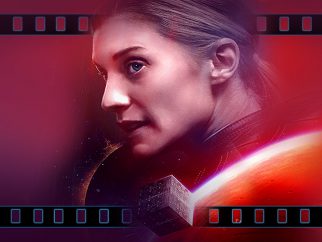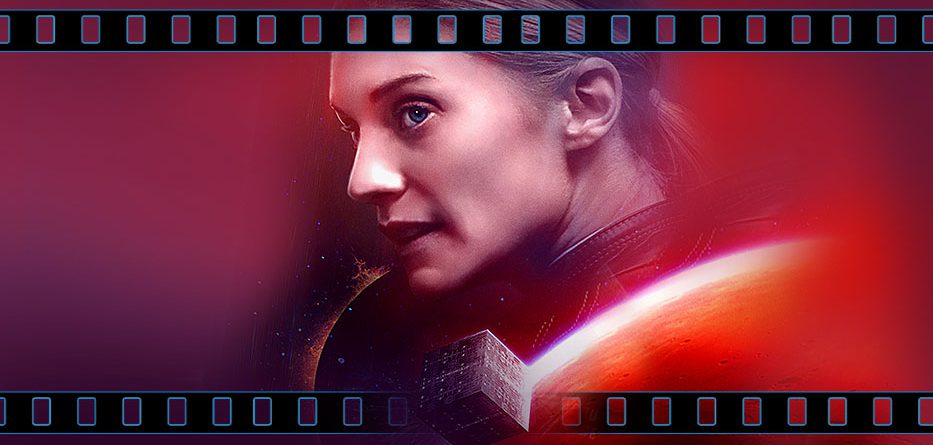When the first manned shuttle to Mars in 2030 ends up with the loss of ship and crew, efforts to find out what happened are initiated. Six years pass and with a massive leap forward in self-building tech, the decision is made to use AI technology to oversee the new mission, supervised by Mackenzie ‘Mack’ Wilson (Katee Sackhoff), the daughter of one of the original scientists killed. Mack quickly finds that her role has been somewhat usurped by ARTi, the onboard AI, with full permission from earth-bound controller Lena, Mack’s sister.
However when an unusual structure is found on Mars surface it soon becomes clear that the mission parameters are beyond what was originally envisioned and that the future of the human race may lie in the decisions that Mack and ARTi make next…
A little film called 2001: A Space Odyssey touched upon the ideas of Earth’s place in the universe, the frailities of the people who travel in space, mysterious monoliths and the dangers of letting an artifical intelligence make decisions on humanity’s behalf. All of these ideas are revisited / borrowed and generally pilfered in 2036: Origin Unknown, but if you don’t think adding a star-date to the title was as much an aspirational marketing ploy as genuine homage to Kubrick’s milestone then I have a bridge to sell you on Uranus.
There’s a fair to middling chance that the first ten minutes of 2036: Origin Unknown could have you reaching for the remote, but should you stick with the whole film for its entire ninety-minutes of running-time, you may wish you had.
The film was shot over a short period on a low budget and there were apparently some production-scheduling hiccups along the way, but none of that really explains the film’s major failings which get spotlighted in the editing and post-production phases. Ambition and ambiguity trump result. And there’s the rub. Look past some of the artificial gloss and 2036: Origin Unknown starts to look very cheap indeed – a couple of standing sets and lots of quick-cuts to Photoshop graphics and clearly model-decorated exteriors leading to a planetarium lightshow on steroids. There may be a HD-quality sheen to those visuals, but the clarity is wasted on some truly lacklustre CGI-composites from the outset. The original mission’s booster-separation looks exactly like the computer animation it is, the Martian surface relies on sticky-taped stilted orange tinting in the camera lens as stock-footage lightning randomly sparks from rolling dust ‘storms’ and an early shot showing the Earth and the Moon in the same frame is not just a masterclass in lack of depth-of-field but has those spheres lit from different directions. That’s sloppy in anyone’s books but particularly unforgivable from a director, Hasraf Dulull, whose background is in special effects and the crutch on which some of this production rests.
Budget isn’t everything and a good director makes the most of his resources, knowing whether something will look better or worse by stretching it. But the accompanying script (predictably co-written by Dullull as well) really doesn’t rise above film-school levels either. In what often feels like a stage play, or more accurately the first table-reading for a rehearsal for a stage-play, the first rule of cinema is broken: ie – show don’t tell. There’s an over-reliance throughout on merely talking about how dramatic something is rather than showing it and the awkward exposition-heavy scenes that follow each plot point drain energy rather than generate heat. Voice-over dialogue, first from the casually-chatty and quickly disposed-of crew of the original doomed Mars mission and then from ARTi,the new base’s AI (looking more like a cross between Disney‘s The Last Navigator‘s giraffe-necked robot and shiny white Eve from WALL-E than HAL) is delivered unconvincingly. Steven Cree provides ARTi’s voice but it’s like a bored human-being phoning in ‘Tech Manuals for Dummies’ sprinkled with fortune-cookies lines such as “Forget what lies behind and look towards what lies ahead…”
Much of the weight of the production falls on the shoulders of Katee Sackhoff – a fan favourite since her days as Starbuck in the wholly superior Battlestar Galactica but here shackled to a computer-room that probably swallowed half the budget. She’s a versatile actor, coming off another successful run in Longmire and once mooted as a potential Captain Marvel, but even she struggles with a role that feels more archetype than character. In some scenes she out-thinks the AI with only a pencil and paper, in others she’s deeply philosophical and in the next minute flippant and funny – essentially leaning in to whatever hoop the script needs her to jump through rather than having a consistent throughline. Other characters such as Mack’s sister Lena (Julie Cox) and corporate intelligence expert Sterling Brooks (Ray Fearon) hover around but their interaction is limited – in the case of Cox all her performance limited to a tv monitor.
2001: A Space Odyssey benefited from its sheer big screen ambition; Moon‘s largely one-hander of a performance and general conceit made it edgy, The Martian made survival an imperative, Contact pondered the human side of exploration and Arrival was slow but sure. 2036: Origin Unknown is a fan-film writ large, one that thinks it deserves to play in that big league but its reach exceeds its grasp and ultimately it has absolutely nothing new to add to the conversation. It’s Interstellar without the breakneck, pulse-pounding action-factor.
Ironically, in the case of this head-scratching, answer-free time-waster – yet another example of a story more suited to a pithy ‘short’ than a ponderous feature – it’s not the origin that’s unknown but a journey that’s pretentious and a destination that’s ambivalent…
2036 Origin Unknown is released on iTunes and DVD from 13th August…

- Story5
- Acting7
- SFX7
- Pacing4








